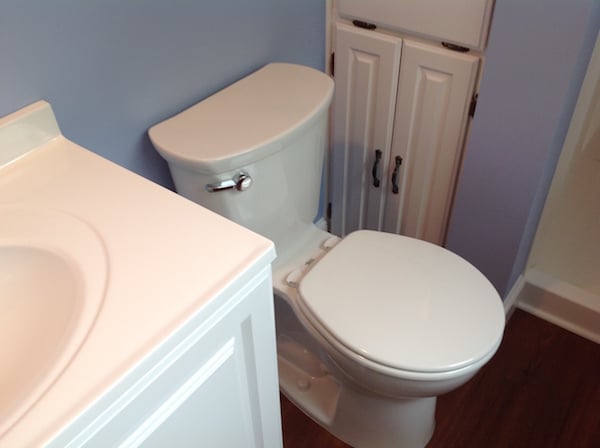On This Page:
- Tools & Materials You’ll Need
- Measuring & Planning
- How to Remove Your Old Toilet
- Installing Your New Toilet
- What to Consider if You Hire
It’s hard to argue against its utility, but like all household fixtures, toilets get old, break down and may even crack and leak. Whether you’re adding a low-flow alternative to save water as part of a bathroom renovation or you’re taking out a broken unit that has just seen too many flushes, installing a toilet is not as tough as it may seem. In fact, an intermediate DIYer with a little plumbing know-how can get the job done (with a little bit of help) in a couple of hours.
Of course, any time you deal with plumbing and sewage there can be backups and backlogs, creating huge messes that will definitely require some professional assistance. In this case, knowing what to ask and what to expect when hiring a pro to install a toilet for you is equally important. Read on to learn what you need to know about toilet installation, from removal to that first flush, and make sure you’re prepared to get the job done, or at least prepared to hire the right person to get it done for you.
Tools & Materials You’ll Need
The tools needed to replace an old toilet and install a new one are pretty basic. However, it’s important to note that these tools and the following instructions relate only to the process used when removing an old unit and putting a new one in its place. Installing a new toilet where there wasn’t one before is a much more complex process that involves advanced plumbing knowledge. In other words, it’s not a recommended DIY project, and it’s often something that requires permitting and inspection. Here’s a list of the basic tools for the replacement task at hand:
- Adjustable wrench
- Tape measure
- Pliers
- Set of screwdrivers
- Bucket
- Putty knife
- Sponge and old rags (use a large car-washing sponge; these hold the most water)
- Work gloves
You will also need several materials to complete the work. These include:
- New toilet — either one-piece or separate tank and bowl
- Wax ring
- New bolts
- New toilet seat and lid (if they’re not included with the toilet you purchased)
Ready to start your toilet installation?
Find ProsMeasuring & Planning
Before you pick up any other tool, take out your tape measure and make sure that the dimensions of your new toilet are such that they will fit in the space of the old one. This is particularly important in older homes with smaller bathrooms and in bathrooms with other renovation features, such as a new vanity. The last thing you want to have is a heavy toilet bowl that won’t fit in a tight area. Here’s what to do:
- Start measuring from the rear wall behind the toilet. FInd the distance from the wall to the center of one of the closet bolts. If your toilet has four bolts, measure to one of the back bolts.
- Next, measure the distance between the center of the mounting hole on your new toilet to the back of that toilet.
- Compare these two numbers. If the second is smaller than the first, you’re good to go.
It’s also important for those in tight-fitting situations to measure the width of the space available from the side of the old toilet’s flange bolts to the wall or vanity next to it. You should compare that measurement to the width of the new toilet to ensure that the new one properly fits into the space.
How to Remove Your Old Toilet
With a properly sized toilet and the right tools in hand, the first step for installation is the removal of the old one. The hardest part of this project is the physical removal of the toilet itself. Be sure to have a partner on hand to help you carry the fixture out to minimize damage to the surrounding area and limit the potential for injury. Then, follow these steps:
- Shut Off the Water – Begin by shutting off the supply line to the toilet — located on the wall or floor — and draining the bowl and tank of water by flushing, plunging and then sponging out any remaining water into a bucket.
- DIsconnect the Supply Water Line – Use an adjustable wrench, taking care to keep the water pipe at the wall or in the floor steady and undisturbed. There will likely be some water left over in the line, so have rags or a sponge ready to clean it up.
- Remove the Tank from the Bowl – If the toilet isn’t in one piece, it’s easier and safer to remove it in parts. Start by disconnecting the bolts underneath the tank with an adjustable wrench. The tops of the screws will likely be inside the tank itself. Once out, lift the tank straight up, wiggling it gently from side to side in order to loosen any rust. This is ideally a two-person job.
- Remove the Bowl of the Toilet from the Floor – Pop off the caps covering the floor bolts and unscrew the bolts with an adjustable wrench or pliers. For older, rusted units, you may need to use a lubricant or other penetrating catalyst like WD-40 or PB Blaster to help. If you still have a hard time, get in a few twists to raise the bolts up, and then sever the screw with a hacksaw.
If the old toilet has been caulked to the floor, use a utility knife to score around the base of the bowl and loosen the caulk. Then, use a slight rocking motion to completely loosen the unit and lift it off the floor. This should expose the old wax ring. Use the putty knife to remove any wax from the old flange, and stuff a rag into the floor drain to prevent any sewer gasses from coming out during the next phase of installation.
Installing Your New Toilet
With the old toilet off and the flange cleaned or replaced, the process of installing a new toilet can begin. Using these simple steps, your basic goal is to reverse the process used in removal, taking care to ensure tight, seamless connections and correct old habits for a better, safer result.
- Inspect and/or Replace the Flange – Begin by inspecting the old flange that was used to bolt the toilet to the floor and connect the wax ring to the sewer pipe. If it’s damaged or cracked, you have two choices: replace the flange outright or use a flange repair ring to reinforce the flange and better hold the bolts to the floor. Once complete, reattach the new flange or flange and repair ring to the floor with screws and a drill bit, place your new bolts inside the flange and remove the rag from the sewer pipe.
- Set the Bowl – Make sure the closet bolts set are upright in the collar slots of the flange, and place a brass washer around each bolt. Ensure that the wax ring is thick enough for the floor under the toilet, and then line it up with the flat side down over the flange, pressing it into the pipe. Carefully, with the help of a partner if available, line the bowl of the toilet over the ring and bolts, and gently lower it into place. Be very careful not to twist or rock the bowl during this process, as doing so can break the wax seal and cause the toilet to leak. Once it’s in place, press the bowl firmly into the wax seal and use a level to ensure that it’s sitting evenly on the floor. If the bowl is uneven, add waterproof or stainless steel shims underneath to balance it out. For minor variations, a few stainless steel washers may be sufficient.
- Attach the Bowl – Place another washer and nut on top of each bolt and begin to secure them. Take care to alternate when tightening the nuts down so as not to apply too much pressure to one side of the bowl and loosen the wax seal. Be mindful of the direction of the wrench as well so you don’t crack the porcelain. Once complete, cover each bolt with a bolt cap. At this point, you can also trim each bolt with a hacksaw.
- Attach the Tank and Supply Line – Check to make sure that the large rubber tank-to-bowl flange is secure and the bolts are in place. Then, place the tank on top of the bowl, taking care to line up the bolts into their designated holes in the bowl. Again, using a second set of hands at this juncture is a good idea. Once it’s set up, place a washer and nut on each bolt and secure the tank to the bowl. Then, reattach the supply line, starting at the tank. Consider getting a new supply line for this step, especially if the old one shows any signs of damage. Turn the water back on slowly and allow the tank to fill.
- Check for Leaks – Make sure all your seals are solid by flushing the toilet and carefully checking each connection for leaks. One way to make the process easier is to add a little bit of leak-detecting dye or food coloring to the tank. It’s a wise idea to flush up to six times in a row to be absolutely certain that it’s leak-free before attaching the seat and wrapping up the project.
Ready to start your toilet installation?
Find ProsReturn to Top
What to Consider If You Hire a Pro
While installing a toilet is a completely possible DIY job, it’s not easy for the plumbing novice or those who are unable to safely lift and place the bowls and tanks into place. Improper placement or too much movement when placing your toilet causes the wax seal to break and eventually leads to leaking or potential damage to the floor of your bathroom. In this case, or in a situation when you’ve removed a toilet and just don’t know what to do next, calling a professional plumber to complete the job is a viable option that presents a relatively affordable solution. In fact, according to real cost reports, the average price to install a toilet is between $213 and $508 and includes removal of the old toilet. More toilet prices can be found on our Toilet Installation Cost Guide.
Even if you do choose to hire a pro, it’s important to know about the steps listed above anyway. This ensures that you understand key terms surrounding toilet installation and understand features such as the role of the wax ring or the flange at the sewer pipe.
Questions to Ask
Prepare for your conversation with plumbing professionals by asking key questions and providing critical information about the toilet installation process and what you expect for your home.
- Identify the type of toilet that you’ve purchased, one-piece or two, and whether or not you’ve taken any measurements to ensure an adequate fit.
- Go over any steps you’ve already taken (i.e. removal, disconnecting the tank from the bowl) and any problems you have encountered thus far.
- Ask the pro about his or her method for finishing a toilet installation. For example, though caulking on the bottom is common practice in many older homes, it can actually hide water damage should the wax seal break, leading to a more costly and complex set of repairs down the line.
- Ask about any existing plumbing lines or pipes, including the sewer pipe if it’s exposed and whether or not these lines may need repair or replacement. A pro can also come and evaluate the plumbing before giving you a quote on installation so that there are no surprises, should the pipes end up needing some work.

 How to Repair, Replace and Install Bathtub Faucets and Shower Valves
How to Repair, Replace and Install Bathtub Faucets and Shower Valves  How to Install or Replace a New Shower Head
How to Install or Replace a New Shower Head  How to Install a Removable, Handheld Shower Head
How to Install a Removable, Handheld Shower Head  Corner Bathroom and Kitchen Sinks
Corner Bathroom and Kitchen Sinks  Pedestal Sinks Create an Elegant Space
Pedestal Sinks Create an Elegant Space 

Should I use pipe dope on all contact surfaces to reduce chance of leak, including rubber to ceramic, plastic to plastic and metal to rubber?